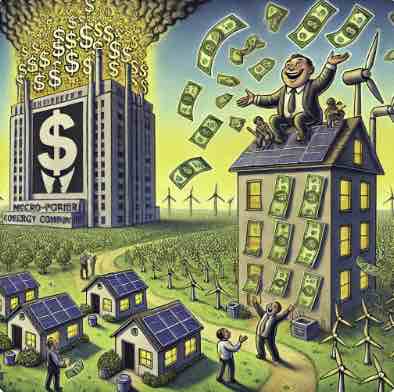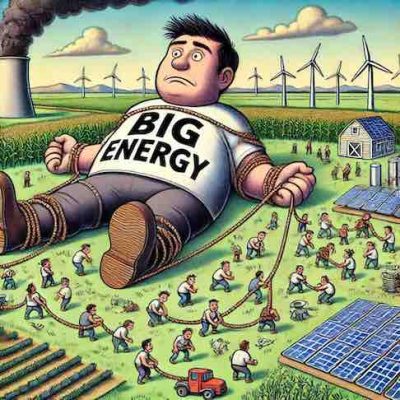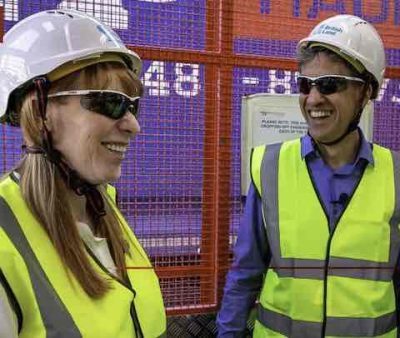
UK Government announcements on energy policy today make clear the profits of international energy companies will trump UK households need for lower energy bills. BBC interviewer Nick Robinson skewered Ed Miliband on a morning interview, in which he accused Labour of “guesswork” over the UK’s energy preparedness. In particular Miliband failed to provide a shred of evidence that prices would drop as a result of the new energy policies.
Each household pays an average of £1750 for energy each year, so it is their money being spent to criss-cross the UK with copper cabling, shipped over from the mines of Zaire and the DRC. The decisions being made now will determine how hundreds of billions will be spent over the next 5 years. And there has been no meaningful consultation with anyone outside of tight circle of Miliband’s favoured energy execs – the same old story.
Miliband promises no power cuts this winter
Only a small part of the total investment is to come from Great British Energy. The multinational energy companies are expected to come up with £40bn a year according to Chria Stark, from “Mission Control”. So far just one major utility company has announced concrete investment plans as part of a vast decarbonisation programme that is supposedly to be completed in the next 5 years.(Iberdrola pledged £22b, although there have been few details.)
“What we are setting out today is a plan for a new era of electricity,” Miliband told millions of listeners on the Today show. But actually there was no plan. No specifics, no roadmap, and no timing for any of his claims.
Still no clue how they will spend the £8.3 billion
There was remarkably little detail about Great British Energy , the centrepiece of the government’s growth mission – no word on exactly how it would be operating, or what its first priorities would be. But enough was released to get a clear picture.
Hidden in the small print of the government’s accompanying press release, was piece of news. It appears the £8.3bn pledged to Great British Energy will be spent almost entirely on local or community energy. That is the good news. On the other hand, much of this money will be funnelled though local authorities which means it may be delayed by bureaucracy, and local interest groups will also slow down projects.
And based on the progress to date, it will be another year before any of those local community funds begin funding actual projects.
The key line in the announcement earlier today was one saying Great British Energy will spend its entire £8.3b on ”increas(ing) the quantum and consistency of Community Funds for transmission networks.”
Note the word consistency. The entire top down approach will dependent on rigid rules, that will stifle innovation and slow down the-already lumbering process to a snail’s pace
Local authorities will have little freedom …

A reckoning is due for Great British Energy – the UK government’s nascent £8.3b industry accelerator. Announced as the centrepiece of the UK “growth mission” its launch was accompanied by the news that it had spent £640m buying the nerve centre of the National Grid – the control room that apportions energy across the country on a live daily basis. In 2035 we may look back on that deal and think “only £640m…” British energy Minister Ed Miliband has firm plans to waste billions by then – on carbon capture and Contracts for Difference, as well as reparations to low-lying islands in the Pacific, and thousands of hotel nights spent attending Cops30-40.
Literally anything could happen to the UK energy supply this winter, and almost all of it is bad.
But there is also something we can all do in our individual communities – to prepare for possible power cuts, this winter or any other winter.
After all, every household in the UK spends an average of £1700 a year on energy.
Ed’s big problem is that he has raised expectations. He announced that not only will he solve the nation’s energy conundrum, but that he will also save money while doing it, keep the lights on, build 1.5m new home and launch a new global Britain on the back of it.
The energy industry, and the entire country, is waiting for action. But Britain can never be an energy super-power, and Ed must know this.
Consider the facts – Annual GB electricity consumption is 292.7 terawatt-hours (TWh) of electricity in 2023, about the same as Texas, a vast state with multiple connectivity issues in outlying areas. The UK has a small, compact grid, which is currently undergoing major re-engineering for decarbonisation.
Electricity demand is forecast to grow at 5% a year, but generation is not increasing at the same pace until 2029. The maximum power to be provided by two new nuclear plants planned (if they are on time it would be a first) is 56TWh. And Ed wants sharp reductions in oil and gas for electricity production. That produces a shortfall of another 50TWh by 2029
Then there is a 10-yr waiting list for new housing estates to get on the grid. That’s right – ten years from time of application to secure a supply from the grid. Yet Labour says it will build at least a million homes in the next 4 years. How will it power the new homes? There is also a 10-yr waiting list for new solar farms to go on the grid, due to structural problems that require hundreds of miles of new cabling and pylons. Quite simply, the grid is not fit for purpose, and nor is there the slightest chance it will be re-engineered until well after 2030. Nevertheless, the government says it wants to decarbonise the electricity system by 2030.…

Richard Black’s new book, The Future of Energy, is impeccably researched, well-timed. and entertainingly written for such a dense subject.
It is also focused on the wrong future.
Black is a highly respected, former BBC environmental science journalist – he left the Corporation over a decade ago because his face didn’t fit in the febrile world of accusation and counter- accusation from climate deniers, and determined greenwashing from the large corporations which had begun muscling in on the funding for environmental tech.
Black’s general approach is in line with the UK government thinking. Their planned Great British energy invesmtnet vehcile will soon be dispensing its modest budget (£8.5 billion) to assist clean energy startups of all sorts – but mainly big ones. Black thinks Coal Oil and Gas are Bad. Clean Energy is Good. Which is perfectly true as far as it goes. But despite his talk about the Rockefeller oil dynasty and the distrust of government that comes through in every chapter – Black still opts for the easy life – adopting the general consensus in the climate industry that the present system will be much like the past but cleaner and better – that we can keep living largely the same way and dong much the same things, but somehow clean energy delivered by large companies will solve our climate problems for us.
This is not the conclusion I wanted to hear, and its all the more strange because a short chunk of the book does pay lip service to off-grid energy. Pages 43-46 of the 200 page book has Black telling us:
“For me, one of the biggest attractions of the clean energy system is the power it confers on people and businesses to make their own decisions. By opting in, people can choose to rid themselves of the daily dependence on coal for the fire, petrol for the car and gas for the boiler…”
He goes on
“With P2P trading, electricity is used close to where it is generated, reducing the need for big transmission cables, substations and other grid paraphernalia.“
The centralised grid, which like most commentators Black wants to see cleaned up “decarbonised strengthened and extended – is more part of the problem than it is part of the solution.
Black’s argument is very much in the mainstream of current thought – he is going with the flow But he would do well to remember that when he argues against Oil, Gas and Coal – he is doing the nuclear industry’s job for them – jsut imageine all those energy industry bosses salivating tat the thought of the extra bonuses they will get when oil is finally stopped. True, Black criticises Just Stop Oil for their performance politics – but he makes the same mistake as JSO – not realising that the culprit is not Big Oil = it is Big Energy that got …

The UK Government last week laid out the domestic plan for its first year in office -prioritise housing and clean energy, in order to kickstart growth.
The duo in charge of these policies – Angela Rayner (housing) and Ed Milliband (energy), did not co-ordinate their announcements last week, and there is a feeling in energy circles that both policies may fall flat for the same reason – delays in generating clean energy to the places where housing is most needed.
Housing and energy are closely connected – you cannot build new communities until the power supply is in place. We know that there is currently a 10 year wait to connect new housing estates to the grid in some parts of the country, and a 10 year wait to connect a solar farm to the grid in others.
The government also launched its vehicle for its energy initiatives last week, Great British Energy, to be run by former Siemens executive Juergen Meier. it is going into the business of picking winners – but energy for housing does not appear to be in the list. £8.5b has been announced for it to co-invest with big industry players in the next generation of wind and solar farms. But these projects take years to start generating power. It took the best part of a decade to build the Hornsea 1 Windfarm, and that was AFTER planning permission was granted in 2014. So reforms to planning permission on which the government is currently consulting are unlikely to make much impact.
And the recent history of government energy deals shows the Civil servants charged with negotiations were ham-fisted and outmanoeuvred at every turn. The UK chair of French energy company EDF, Alex Chisholm, previously ran BEIS, the department that struck the deal for EDF to build a new nuclear power station in Somerset., as reported in the Guardian. “The agreement was made in 2016 with UK bill payers bearing the costs, which soared from an estimated £18bn to at least £31bn…. it is due to be completed in 2031 – about 14 years after EDF said it would be up and running.” In 2023, EDF was the leading company in the wholesale electricity generation market in Great Britain, with a share of 18.5 percent. The UK branch of the German company RWE ranked second last year, with a market share of approximately 17.5 percent
Data centres and EVs will gobble up all the new energy the grid can produce in this country for the next ten years.
Where does that leave the new housing starts that are so badly needed? How will they get their energy this year?
The big energy consumers will always need the grid, but for at least some new housing estates, electricity could be supplied from small local microgrids that do not need to be hooked up to the main grid …

Whatever your views on the Arab-Israel conflicts, and on the Hamas atrocities of October 9th, nobody can no doubt that the humanitarian crisis demands immediate action by all of us – especially now that UNWRA has been exposed as a deeply suspect organisation. Sending money to huge bureaucracies like Save the Children or UNWRA – you know for sure that much of it goes in admin, bribes and other priorities than your own.
So if you want to help Palestinians on the ground in Gaza, who are surviving on tiny morsels of food, limited water and intermittent energy, if you want all your money to go straight to those in need – then we have a way.
Our cameraman in Gaza, will spend what we send him on buying solar panels, and film himself donating them to ordinary families. He has already been donating cash this way – brought in via Egypt.
He shot our latest Youtube footage, showing him distributing donated money – 50 shekels at a time. You can see the ID cards of the women as he hands them the money. You can see they are innocent citizens and not terrorists. Watch the video on our socials, and tell your friends.
Insta
https://www.instagram.com/reel/C3SFn31IQld/?igsh=a3Nxa3R4YjFnNDZo
Facebook
https://fb.watch/qaYFhPNFqc/
Tiktok
Banned
Youtube shorts
But solar panels are more valuable than money – they are the gift that keeps on giving. We have found a supply of panels in Gaza, and any donations received will be used to purchase them and give them to communities in need of energy to power their lights and phones.
Please paypal to nick@off-grid.net and we will get the money straight out there the next day.
Mark your paypal: Solar Panels for Palestine.…

Mirissa beach is known for cool Eurotrash, beautiful surfing and whale-watching. In common with most of the country outside the dapital, the beach community struggles with an unreliable electricity grid. But it is not known as a centre of off-grid technology – and for good reason. Like most of the country, households in Mirissa depend for backup power on diesel rather than solar. The Perkins generator at the Seastar Hotel is a relatively modern example of a near-century-old design.
It sits in the courtyard of this friendly hotel, maintained by locals, at the end of the long golden beach, that has become increasingly popular over the years.
Western surfers share the waves with Sri Lankan fishermen, who hover near the shore all day, line fishing, while most of the catch is hoovered up by industrial vessels on the horizon.
When the power goes out, about once every couple of days, the huge old generator roars into action. It certainly helped me out when I was trying to go online. Happy Birthday, Generator. You can see the film here.…

The tragic war in Gaza has left hundreds of thousands off the grid – with no water or power and very little food.
Off-grid has obtained exclusive footage from the streets of Southern Gaza – available to watch on our youtube channel – offgridnet .
It is quite dangerous to gather this footage and our thanks go to our long-standing cameraman in the region. We are not naming him for security purposes.
After they queue for hours at aid stations for tiny amounts of sustenance, and to recharge their phones – Gaza residents then return to bombed-out shelters to cook morsels of bread on campfires and go to the toilet in whatever unused corners they can find.
They search the trash for materials for their fires to cook by. Off-Grid.net is trying to send solar panels and batteries to Gaza but there are many obstacles.
The Israeli army prevents batteries and solar panels from getting through, claiming the equipment has a military purpose. But this claim ignores the humanitarian emergency unfolding, and makes Israel’s IDF look as though they are deliberately imposing siege conditions on the Gaza population.
Hospitals are another place where Gazans can charge their phones and pick up water.
Please contact us if you want to help us provide off-grid aid to Gaza – contact
Please contact us with footage from off-grid zones, anywhere in the world.…

UNCTAD Secretary-General Rebeca Grynspan has issued a rallying call for 2024, in a statement claiming that the rich countries are using the green transition as an excuse to boost their own economies at the expense of developing ones. According to the UN’s trade chief, the world’s advanced economies are greenwashing to make their own eco-credentials look better, while preventing poorer countries from developing quickly.
Grynspan attacked the EU for taking Indonesia to the WTO over its restrictions on nickel exports and requirement to process the ore locally. She said Jakarta wanted to move up the value chain by making products from the nickel. It is only reasonable for a country with an overstretched electricity grid to want to use its own nickel tp produce its own batteries, fro example – rather than being forced to export to China or Canada.
UNCTAD Secretary-General Rebeca Grynspan has issued a rallying call for 2024, in a statement claiming that the rich countries are using the green transition as an excuse to boost their own economies at the expense of developing ones.
“They don’t want it to be exported in the raw form, but with value added. So they were taken to arbitration in the WTO. They lost in the first instance precisely because global trade rules have not been adjusted,” she said. She said that the Agreement on Trade-Related Investment Measures should be reformed. Jakarta has appealed but because the US has blocked the formation of a WTO appellate body, the case has stalled. The EU is considering taking enforcement actions such as tariffs on Indonesian goods. It makes for a “chaotic system” where richer, bigger countries have more power.
“Many trade rules forbid policies that can be used by developing countries. And the developed countries have more fiscal space to subsidise in the areas that are good for ‘quote, unquote’, the environment,” Grynspan, told the Financial Times in an interview.
She said the international trading system, which had allowed states such as South Korea and her native Costa Rica to progress, was no longer working for the poorest. “Trade and investment have been the two pillars for developing countries to really go on to a path of dynamic growth,” she said. But they now face two big problems, locked out of markets by the fast pace of technological change and facing new barriers erected in rich countries. “The least digitally prepared countries are falling farther behind in digital,” said Grynspan. “The other problem is that industrial policy …could affect developing countries’ ability to compete.”
The US landmark Inflation Reduction Act has $369bn of subsidies and tax breaks for domestically produced goods such as electric vehicles. The EU has responded in kind with increased subsidies and policies to stimulate production of silicon chips, critical minerals and green technology. “Developing countries see a lot of these policies as protectionist. They don’t have the …

In the race to Net Zero, the construction of the world’s largest carbon capture facility in Texas exposes all the contradictions of the energy industry in one emblematic project.
The importance of the Petra Nova plant cannot be overstated. By burying the CO2, its backers believe they can eliminate the biggest single criticism of fossil fuel consumption. Bloomberg breathlessly reported it would sequester “1.4 million tonnes” of carbon per year. This sounds like a lot, and The Guardian report says “The plant will inject 500,000 tons of carbon dioxide into the ground each year.” Whichever, its success would be a proof of concept for the fossil fuel industry. Hundreds more plants would follow, say the owners, JX Nippon. But a careful look at their figures shows their claims just do not add up.
Positioned as a crucial solution to avert climate catastrophe (if it actually works) the “$1bn” facility aims to capture and store carbon dioxide emissions from a nearby coal-fired power plant. Petra Nova began operating in 2016 at the power plant in Texas, and shut down less than four years later after a fire (and following a plunge in oil prices during COVID-19). It restarted on Sept. 5, JX Nippon said last month.
The W.A. Parish Generating Station is a 3.65-gigawatt (3,653 MW), dual-fired power plant located near Thompsons, Texas. The station occupies a 4,664-acre site and consists of two four-unit plants; one natural gas and the other coal (2,697 MW). With a total installed capacity of 3,653 MW, it is the second largest conventional power station in the US, and supplies about fifteen percent of the energy in the Houston area. Critics argue it was initially responsible for the rolling blackouts of the 2021 Texas power crisis.
As mentioned above, and reported in breathless tones by Bloomberg, the carbon capture plant claims it can bury 1.4 million tonnes a year – but the coal-fired power station emits over 16 million tonnes per year, (assuming it is operating at 70% capacity). And the Gas-fired plant would emit another 3 million tonnes (at 70% capacity). So the claims of 1.4 million tonnes of CO2 per year, which Reuters reports as a target but Bloomberg report as an actuality, is less than 10% of total emissions from the power plant. It would require another $9 billion of investment just to sequester all the CO2 from this plant alone.
With some viewing carbon capture as nothing more than a distraction backed by the fossil fuel industry, the above analysis shows the maths of the Petra Nova project just dont add up. If it wasnt for the government subsidies the plant would not make anything like enough to pay for itself, and produce a return on investment.
So if the Petra Nova project really is a huge white elephant, then what is it all about really? Why would some …

To say that the United States electrical grid is outdated would be an understatement. Built largely during the first half of the 20th century, the grid has struggled to keep up with the explosion of electrical demand and technological advancements. It’s a patchwork system, plagued by inefficiencies, that was not designed for the diverse energy needs of the 21st century.
The electrical grid’s limitations aren’t just a theoretical problem; they have real-world implications. Extreme weather events, which are increasing in frequency due to climate change, pose significant risks. The recent Texas energy crisis, where a winter storm left millions without power, is a glaring example. Natural disasters like hurricanes and wildfires also highlight how easily large sections of the grid can be knocked out, leaving communities without essential services for days or even weeks.
The centralized nature of the U.S. grid further compounds these issues. The existing structure often creates monopolistic scenarios where a single provider controls a regional grid, limiting competition and innovation. This affects not just pricing but also the motivation to transition to cleaner, more sustainable forms of energy. The end result is an inertia that is hard to overcome.
One promising way to address these myriad issues is through the adoption of off-grid energy solutions. Off-grid systems, often based on renewable energy sources like solar and wind, are modular by design, meaning they can be scaled up or down as needed. This provides a unique flexibility that the traditional grid simply cannot offer.
One of the most significant advantages of going off-grid is the potential for local energy production. Communities can produce their own electricity, thereby reducing the distance that electricity has to travel. This not only minimizes transmission losses but also reduces the vulnerability to centralized grid failures.
By encouraging off-grid solutions, we move towards a more decentralized energy model. This fosters competition and allows communities to tailor their energy systems to their specific needs, whether that be cost-efficiency, sustainability, or resilience.
Incorporating off-grid energy solutions like solar panels and wind turbines can also significantly reduce greenhouse gas emissions. By shifting away from fossil fuel-based electricity, off-grid systems offer an environmentally friendly alternative that aligns with global sustainability goals.
Given the clear advantages of off-grid systems, there’s an urgent need for legislative action. One such change could be modeled on the UK’s Electricity Act of 1989. A new category, “Local Energy Producer,” should be introduced, granting off-grid solutions a formal standing within the regulatory framework. This could involve tax incentives, grants, or subsidized loans to encourage local communities to invest in off-grid energy solutions.
The limitations and vulnerabilities of the U.S. electrical grid are not insurmountable problems; they are challenges that present an opportunity for transformative change. Off-grid energy is not …
Two British companies have been named among 15 nominees for the 2023 Earthshot “Green Oscars.” Just five of the finalists will get £1m each for their solutions to some of the earth’s most intractable environmental problems.
The stand-out nominee is Enso is a car tire manufacturer with a revolutionary product. There are 1.5 Billion vehicles on the planet – all running on tires which give out thousands of tiny particles, so small they are lodged in the lungs of humans and animals.
While major producers, including Goodyear (GT.O), Bridgestone (5108.T), Michelin (MICP.PA) and Continental (CONG.DE), are trying to fend off competition from cheaper Chinese rivals, Enso has pioneered a tyre which is not made from fossil products, and has none of the toxicity of normal tyres, which on average contain about 200 components and chemicals, often derived from crude oil.
This year, California is expected to be the first authority to demand tyre-makers demonstrate they are seeking an alternative to 6PPD – a degraded form of which is lethal to some fish and has been found in human urine in South China.
The European Union’s upcoming Euro 7 emission regulations will set standards for tyres for the first time. “It’s not quite a perfect storm,” said Gunnlaugur “G” Erlendsson, CEO of UK-based startup Enso, which has developed more durable tyres specifically for heavy EVs, which Michelin and Goodyear have reported can wear out tyres up to 50% faster.
“The unintended consequence of electric cars is we’ll have more tyre pollution unless we have better tyres,” said Enso’s Erlendsson, whose tyres, in testing emit 35% less than premium EV tyres from major manufacturers. But that still makes them reponsible for hundreds of deaths per week worldwide.
Bridgestone and Goodyear declined to discuss the industry’s emissions challenges.
But Michelin, Continental and Pirelli (PIRC.MI) told Reuters they are pursuing alternatives to 6PPD, with Michelin and Continental adding collective industry action may be necessary to find solutions.
Asked about Euro 7 regulations, Michelin said it wants worldwide standards to squeeze the higher emitting tyres, which are usually cheaper, out of the market. Continental advocates a global abrasion standard with transparent labelling for consumers.
Nick Molden, CEO of British-based testing specialist Emissions Analytics, said the “dirty end” of the list of tyres the company has tested are “cheap Chinese imports” common in the European market.
The Chinese makers of Rockblade, Mazzini and Ovation – among the worst-performing tyre brands on Molden’s list – did not respond to requests for comment.
Data provided to Reuters by Emissions Analytics shows new tyres from the large makers developed so far are unlikely to solve the problem.
For example, while tests carried out on Continental bicycle tyres made using dandelions show a 24.5% drop in carcinogenic aromatics – which help cars hug the road – the chemicals in the particles they emit are similarly toxic overall, …